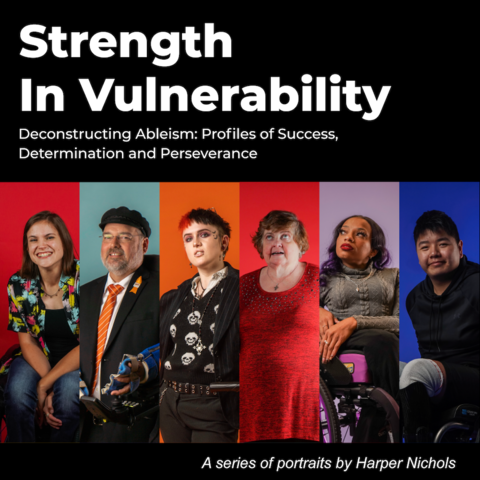 A new exhibition of photographs highlighting people who live with physical disabilities — and taken by a recent University of Alabama at Birmingham graduate who has cerebral palsy — will open Thursday, Jan. 26.
A new exhibition of photographs highlighting people who live with physical disabilities — and taken by a recent University of Alabama at Birmingham graduate who has cerebral palsy — will open Thursday, Jan. 26.
“Strength in Vulnerability – Deconstructing Ableism: Profiles of Success, Determination and Perseverance” explores ingrained, internalized ableism and inclusion, acceptance and advocacy to discuss issues that the community continues to face.
Photographer Harper Nichols and filmmaker Ingrid Pfau worked with the UAB School of Health Professions and the National Center on Health, Physical Activity and Disability to create the exhibition. Nichols, a December 2022 graduate who earned a Bachelor of Fine Arts degree with a concentration in photography from the UAB College of Arts and Sciences’ Department of Art and Art History, focused on her own disability for a photographic series while in school. Pfau graduated from UAB in 2011 with a bachelor’s degree in environmental science filmmaking, an individually designed major. A member of the Honors College University Honors Program, she was the first UAB alumna to receive the Jack Kent Cooke Graduate Arts Award.
Over the last six months, 18 different participants who all live with varying disabilities were photographed and interviewed for “Strength in Vulnerability — Deconstructing Ableism.” Each person in the project spoke openly about their personal experiences living with a disability and dealing with external and internalized ableism. See their imagery, video and information both at the exhibit and online at www.uab.edu/shp/home/cedhars/art-installation.
The art exhibition can be seen by reservation only in the UAB Wellness, Health and Research Facility located on the campus of the Lakeshore Foundation, 3810 Ridgeway Drive, Birmingham, AL 35209. See the art and meet the artist at the opening night unveiling 5-7 p.m. Jan. 26. The opening is free to everyone, but registration in advance is required to attend. Register online.
Ableism is deeply ingrained in most of us whether we realize it or not, says James Rimmer, Ph.D., Lakeshore Foundation Endowed Chair in Health Promotion and Rehabilitation Sciences at UAB.
“I believe this powerful exhibit will impact how we look at our own bodies, as well as the bodies of disabled people,” Rimmer said. “It is rare to see a photo exhibit where the photographer and the subjects have disabilities — it is a unique opportunity for people to see where disability, accessibility and ableism intersect and where determination flourishes.”
In completing this project, Nichols, whose own disability, cerebral palsy, affects the use of her right arm, says she has begun to feel less alone in her own experiences with ableism and internalized ableism. She has been encouraged by the willingness of the participants to share their own experiences and stories — something she was previously hesitant to do.
“This project has changed the way I think about my own disability,” Nichols said. “I have learned that being vulnerable and open can connect people in a truly meaningful way.
“These are realistic stories of people who are doing real things — in a real community and a real space — and how they have succeeded,” she said. “I’m hoping that it opens a door to conversations about what is ableism and what is internalized ableism.”
Nichols last year trained the camera on herself and photographed only her arm as the subject for a self-portrait assignment in class. Because she is not able to grip things with one hand, her arm has become her own personalized holding device, she wrote in her project statement. The series, “holding / self portrait,” showed all the things she holds throughout the day with her arm. How she fulfilled that assignment influenced her artistic practice, and changed how she relates to other people, she says.